13 said no.
One said, “Oh yeah. They’re amazing!”
That friend was a jazz singer.
If you like Pentatonix, GQ, Take 6, The Manhattan Transfer, the Andrews Sisters or Lambert, Hendricks & Ross––thank the Boswell Sisters. They invented the jazz vocal ensemble.
“Without the Boswell Sisters there would be no Andrews Sisters.” -Patty Andrews
If you like Diana Krall, Bobby McFerrin, Wynonna Judd, Billie Holiday or Ella Fitzgerald––thank the Boswells again. They developed the modern approach to jazz and pop singing.
“Who influenced me? There was only one singer who influenced me. I tried to sing like her all the time, because everything she did made sense musically… and that singer was Connie Boswell.” -Ella Fitzgerald
The Boswell Sisters are one of the most awe-inspiring and important groups to have ever made music.

Connie, Vet, Martha
In a 3-minute song, a Boswell Sisters’ arrangement can seamlessly traverse through multiple key changes, several 90-degree tempo shifts, complete reharmonization of various sections, scatting, gulling, lyrics sung in “gibberish,” and all mesmerizingly executed with jaw-dropping style and a wondrous sense of swing.
After many years as a music professional, I cannot believe I was unaware of this stunning vocal trio until January 2015, when I stumbled upon them by accident while surfing the Net. I watched the live 2-minute film clip of “Crazy People”–– and that was all it took. I was hooked. Or, as Boswell Sisters aficionados say, I was “Bozzed.”
This was a new musical world. A wild take on jazz with no words to adequately describe it. I launched a YouTube quest for as much Boswell Sisters music as I could find. Fortunately, many of their tracks are posted on YouTube and CD reissues are readily available on Amazon.
Before you read any further…check out the “Crazy People” video.
For those who have not taken the trip to Planet Boz––you are in for one doozie of a ride.
The Boswell Sisters – “Crazy People”
The Boswell Sisters were the most popular music group in America from 1931 to 1936.
Then suddenly, in 1936, it was all over.
They quickly faded from the scene––and the public’s memory.
So…who were they?
And why was this incredible trio largely forgotten?
SHUFFLE OFF TO NEW ORLEANS
Fate can be like a slot machine. The tumblers must align themselves in just the right way to trigger a jackpot. The Boswell Sisters’ story is like that. There’s everything that makes a compelling tale: tragedy, victory, loss, pain, luck, secrets, betrayal, talent, and a deep love forged by strong family bonds. The sisters had an incredible ability to turn adversity into triumph, making the most of every opportunity. Their saga is as compelling as their music.
The “Bozzies” (as they are affectionately called) were three bright, über-cute, funny, playful, and extraordinarily talented sisters: Martha (1905-1958), Connie (1907-1976) and Helvetia (1911-1988, known as Vet).
While the girls were very young, the Boswell family settled in New Orleans. With its eclectic blend of cultures and the sound of blues, jazz and gospel all around them, these three brilliant young women––encouraged by musical parents and a strong-willed mother––created a sound so fresh, so unique, that it caused a musical sensation, changing the face (and ears) of popular music.
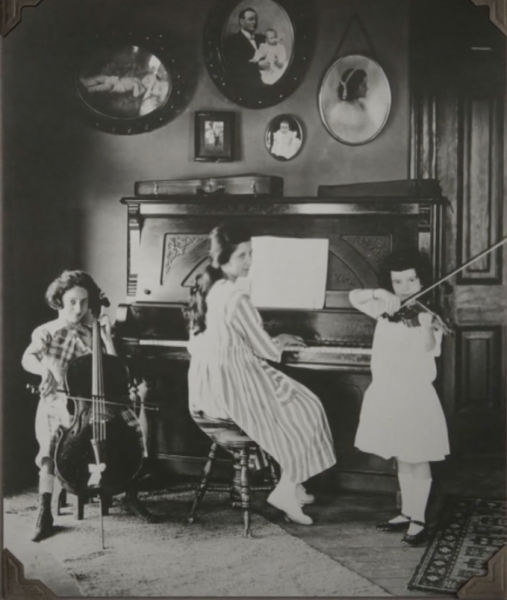
The Early Boswells
CONNIE–cello MARTHA–piano VET–violin
THAT’S HOW RHYTHM WAS BORN
“Their music hit me right between the eyes, and what hit me was their originality. There was just no one like them.” -David McCain, Boswell authority
The young Boswells were trained to be classical instrumentalists. The very essence of music coursed through their veins; Martha was going to be concert pianist, Connie, a cellist, and Vet, a violinist. Yet something else began tugging at their heels.
In a 1925 interview with the Shreveport Times, Martha said: “We studied classical music. . .and were being prepared for the stage and a concert tour throughout the United States, but the saxophone got us.”
Connie traded her cello for a tenor sax, Vet took up the banjo and Martha’s classical piano arpeggios morphed into hot jazz rhythms and ragtime licks.
Though untrained as vocalists, they sang amazingly well together––with that ethereal, other-worldly blend that seems reserved only for talented siblings with genetically-linked vocal cords. And they were connected in even more profound ways.
David McCain comments: “They did have an uncanny telepathy with each other. It wasn’t only just their musical skill and ability. It was this telepathy they had…which even went beyond just being sisters. It was really being in tune with each other. It’s certainly evident on the records when you hear it.”
Three personas forged into a single musical tour-de-force. They sang with an inspired, surgical precision never heard before, nor equaled since. Together they charted a new course in music where no road map existed.

Connie (bottom) – Martha (middle) – Vet (top)
BETWEEN THE DEVIL AND THE DEEP BLUE SEA
“Connie Boswell is the most widely imitated singer of all time.” -Frank Sinatra
A surprising fact about the Boswell Sisters: Connie was confined to a wheelchair.
At the age of 3 either she was either severely injured when ejected from a careening homemade go-cart, had contracted polio, or both (each story was alternately told by Connie through the years). A further incident at age 22, involving a 15-foot fall from a window during a game of hide-and-seek, took away whatever remaining lower-body ability she had. The end result: she never walked again.
For their early gigs, Connie was carried “packsaddle” style by her sisters; Martha and Vet interlocked their forearms while Connie sat in the middle. They learned to rely on each other in profound ways: physically, musically, emotionally and spiritually. This intimacy was reflected in the music they created.
Vet’s daughter, Chica Boswell Minnerly, observed: “They went everywhere together, socially. They did things together. Played their music together. And they thought alike. When you have that kind of closeness and you translate it into a musical form, it’s hard to explain what happens…with a trio. A trio begins to have its own identity. And that identity is very different from any of the sisters. So it becomes truly a trio.”
In the 1920s jazz was often referred to in derogatory terms, especially by religious groups (in the 1950s these same charges would be leveled at rock and roll).
Chica continues: “Jazz, in some circles, was considered ‘the Devil’s music.’ But it was hard to call it ‘the Devil’s music’ when you had these three pretty little girls…one of whom couldn’t walk…and they’re singing this music. So it presented a contradiction. It’s interesting, because people had to make their minds up about it.”
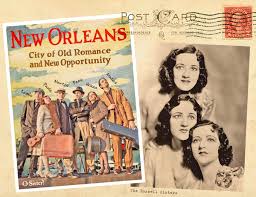
ROLL ON, MISSISSPPI, ROLL ON
By 1929 the Boswell Sisters were New Orleans favorites. But if they wanted a higher level of success, they needed to play venues further from home.
So the young ladies hit the road, performing in an unglamorous sector of the Vaudeville circuit. Their show featured playing instruments––Martha on piano, Connie on sax, Vet on banjo (and some tap dancing), doing popular songs of the day. Oh…and a little singing was pitched in.
At their first out-of-town gig, in a small, dingy theatre in Chicago, the trio was suddenly stricken at show time with a serious case of stage fright. They were so nervous that they left their instruments backstage––all they could manage to do was sing to Martha’s piano accompaniment. When they finished, the stage manager, noticing their discarded instruments backstage, asked: “Don’t you girls do anything but sing?”
Ah, but fate was tampering with those slot machine tumblers––it was through their singing that they would create a musical sensation.

Vet, Martha, Connie
Their tour ended up in Los Angeles, where the radio work was. One day Connie showed up for a live broadcast with a bad cold. She suggested the songs be transposed down “an octave or two,” and sing soft and close into the microphone. This close-mike technique is one of the first examples of using the newly developed electronic microphone for maximum effect. This gave the trio an important component of their signature sound.
While doing radio shows in California, a letter came into the station with a scathing review. It was Martha who opened it. The listener wrote: “Get rid of those awful Boswell Sisters––they’re always changing the melody, and whenever they come on the radio, me and my friends turn them off.”
It closed with a bristling coda: “We call them the savage chanters.”
Martha was so upset at this harsh critique that she broke down in tears. She was about to rip up the letter when Connie snatched it from her hand. Connie said it was proof that the trio was indeed doing something different, and that they should keep on doing it.
With the experience gleaned from touring and consistent radio work, it was time to move to New York, where the jazz scene was in full swing. It was 1930 and the Boswell Sisters were getting ready to take on the world.

Martha (bottom) – Connie (middle) – Vet (top)
THE MUSIC GOES ROUND & ROUND
The Boswell Sisters came along at the right time. Vaudeville was giving way to that new invention––radio––which grew rapidly from a curiosity to a widely accepted form of entertainment.
Recorded music was also going through a seismic transformation. Early recording technology used a crude horn to channel the sound. By 1925 the electronic microphone finally made it possible to capture nuances never heard in a recording before.
The Bozzies made their first few recordings (into those horns) in 1925. By the time they got to their main body of work, starting in 1931, the electronic microphone was firmly established as the new standard.
Like today’s Internet, with the popularity of Facebook, YouTube, Twitter, Instagram––the sisters embraced the technologies of their day: radio, records and films. These burgeoning media marvels allowed them to reach a far wider audience than was ever possible through live shows alone.
And the New York scene is where the sisters would find the success they worked so hard for.
Records in the 1930s meant a live studio performance. There was no tape, overdubbing, or editing. Each take was recorded in mono onto a wax disc––worlds away from modern digital recording. There was no concept of “fix it in the mix.” The performance had to be good or the “waxie” was tossed. The Bozzies went through a lot of “waxies” before they were satisfied with a record.
In the studio, they were fortunate to work with some great musicians of the day, many of whom later became well known: Glenn Miller (trombone and arranger), Tommy Dorsey (trombone), Jimmy Dorsey (alto sax), Benny Goodman (clarinet), Artie Shaw (clarinet), Bunny Berigan (trumpet), Manny Klein (trumpet), Joe Tarto (bass/tuba), Eddie Lang (guitar), Dick McDonough (guitar), Carl Kress (guitar), Joe Venuti (violin), Victor Young (violin) and Stan King (drums). They also worked with the orchestras of Jimmy Grier, Victor Young and Paul Whiteman.
Many of these celebrated musicians were members of AFM Local 47 (Hollywood): Benny Goodman, Tommy and Jimmy Dorsey, Artie Shaw, Bunny Berigan, Joe Venuti, Manny Klein, Joe Tarto and Victor Young.
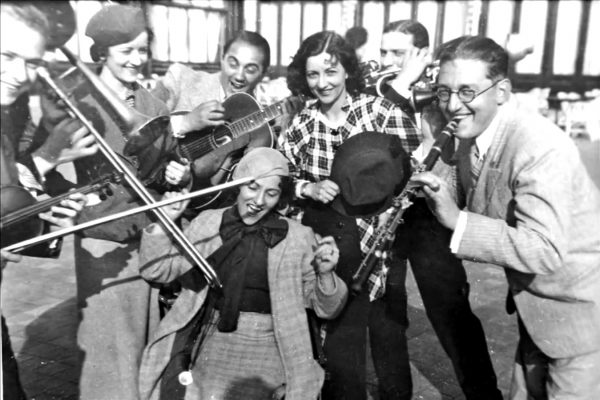
Hamming it up with The Ramblers band during the first European tour.
So how could three white middle-class southern gals come to sound like a sassy trio of soulful jazz singers? Most people who heard them. without seeing them, assumed they were black. Their influences included gospel, jazz, blues and “race” records. Connie was a fan of early blues vocalists Bessie Smith, and especially Mamie Smith––whom she patterned her style after. Her other two major influences were a disparate pair: hot-jazzer Louis Armstrong and operatic tenor Enrico Caruso.
The Bozzies’ vocal sound is a curious combination. Martha and Connie were contraltos, while Vet was a mezzo-soprano with an exceptional range. The typical vocal registers were thrown out the window, because they had the uncanny ability to shift parts at will, creating ever-morphing three-dimensional sonic shapes.
Martha called this “blending.” Connie referred to it as “passing harmony.” Whatever you call it, it meant that the melody could continually move between the three voices. The shuffling of parts, the rapid tempo changes, the modulations and continual reharmonization––indeed rising to the level of recomposition––make that unmistakable Boswell Sound. Nobody had done music this way before. Or since.
In a 1965 interview, Connie reflected on the trio’s sound. She said when people heard them for the first time, they couldn’t believe they were sisters, because “no family could have 3 sisters who could sing like this.” At the same time, they HAD to be sisters, because “no 3 voices could possibly blend this well without being from the same family.”
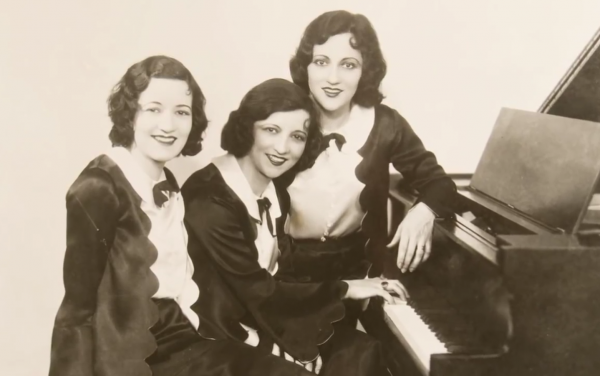
Vet, Martha, Connie
Their father, A.C., a former Vaudevillian and Barbershop singer, taught them a language he called “gibberish.” It’s a zany, word-morphing, pig-Latinish kind of thing––and the girls loved it. This “gibberish” shows up in a number of their recordings. A variation on “gibberish” is heard on the second section of “Everybody Loves My Baby,” which features nonsense sounds sung at an insanely fast tempo, performed with perfect diction in astonishingly precise 3-part harmony––a typical Bozzie Dazzle Moment.
Everybody Loves My Baby
Every time I hear this track, a jolt of electricity shoots up my spine. The vocal histrionics are as energetically wild as they are highly disciplined. Connie even “gulls” (a technique of extreme glottal stops) in the middle of everything. Hey, if this doesn’t get you to sit up and take notice, you’re in a musical coma.
The sisters created all their own arrangements, working collectively, each sparking off the other. But just how did they come up with these wildly inventive sound canvasses?
Connie provided some insight in a 1932 interview: “The method we use is rather quaint, and I know will amuse you when you hear about it––we learn our songs backwards! …That is to say, we start at the end of the chorus and work back to the beginning. None of our arrangements are written out. Once we learn a song we never forget the arrangement.”
Onstage, Martha played piano accompaniment (and on most of their recordings). Connie sat next to her on the piano bench and Vet stood behind, resting one hand on each sister’s shoulder, choreographing the trios’ movements.

Connie, Vet, Martha
Shout, Sister, Shout!
A Boswell Sisters’ theme song; truly a pocket symphony.
In a span of 3 minutes, it’s quite a ride through snappy jazz textures, dark gospel, fast scatting, all culminating in bayou-infused swampy soul.
The fact that these beautiful and talented young women become so successful in a world dominated by men––at a time when women had only fairly recently been given the right to vote––is testimony of their sense of empowerment as females. They went on the road with no chaperones, managed their own business, and charted their own destinies.
The Bozzies were also in control, and responsible for, their musical creations. Rare for recording artists at that time. Their unique musicality, uncanny skill, playful hearts and wistfully “witchy” soulfulness kept them leagues ahead of any competition.
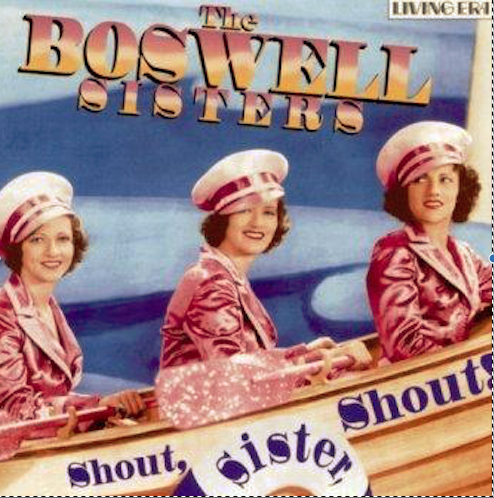
Two new phrases entered the musical language of their time: “Boswell Sound” and “Boswell Rhythm.”
“Boswell Sound” referred to their ability to conjure up unusual and infinitely appealing vocal harmonies, coupled with an astounding vocal blend and wildly creative arrangements with unexpected changes, and amazing vocal gymnastics.
“Boswell Rhythm” was their jazzy, syncopated phrasing and astonishingly precise tempo changes, all executed with an extraordinary sense of musical swing.
Rhythmically, they could push the pulse so it sat on the leading edge of the beat––almost rushing, but not quite. This aggressive hanging over the leading edge of the beat was also called “New Orleans drive.” Many musicians from that scene played on top of the beat, but nobody sang quite like this. And 3 people doing it in perfect synchronicity? Only the Bozzies could do it this incredibly.
Heebie Jeebies
Their good-luck song. The spirit is as intoxicating as the smell of down-home southern gumbo.
A classic Boswell madcap slap-dash romp through many tempo and textural changes, the first-ever 3-part harmony scatting–– delivering a salvo of infectious musical energy that inevitably leaves the listener smiling…and breathless.
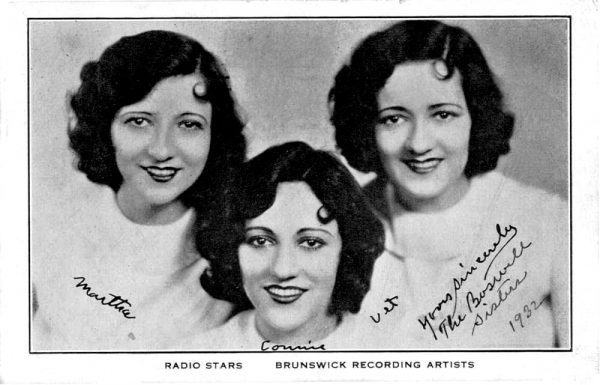
IT DON’T MEAN A THING, IF IT AIN’T GOT THAT SWING
When the Bozzies recorded their first side for Brunswick Records, “When I Take My Sugar To Tea,” (their first charted hit), the veteran studio musicians expected a typical session with your average young vocal group. They got anything but. The sisters possessed a musicianship equal to their own. The music was challenging, the girls were accomplished, charming and fun, and the players were given latitude to improvise solos in their own style.
When they finished the first successful run-through of the song, all the musicians spontaneously got up––and gave the sisters a standing ovation. This kind of thing simply did not happen. This was a moment vital to the trio’s sense of self- confidence.
The Boswell Sisters were definitely on their way.

Connie, Vet, Martha
WE’RE ON THE HIGHWAY TO HEAVEN
From 1931 to 1936 the Boswell Sisters rode the wave of their greatest popularity. They racked up 20 hits on the US charts, and a #1 in 1935 with “The Object Of My Affection.”
They sold 75 million records at a time when many Americans didn’t even have enough money to buy fresh bread. This was the Great Depression. Americans found the sisters’ music so uplifting, so transportive, that it helped momentarily lift the nation out of its collective miseries. Their music reminded people of the joy of being alive at a time when all that seemed to lay ahead for the country was more gloom.
“You know, they never cartoon folks unless they are known world wide.” -A. C. Boswell, father (in a letter to his daughters)
For some reason, history has generally underestimated the impact, revolutionary sound and popularity that the Boswell Sisters had. If any musical act has the right to use the word “magic,” it certainly is the Bozzies. Music publishers rarely gave permission for artists to alter songs. Of course, the Boswell Sisters were the exception. Their changes invariably added to the compositional intrigue of the song (the fact that they also sold a lot of records didn’t hurt).
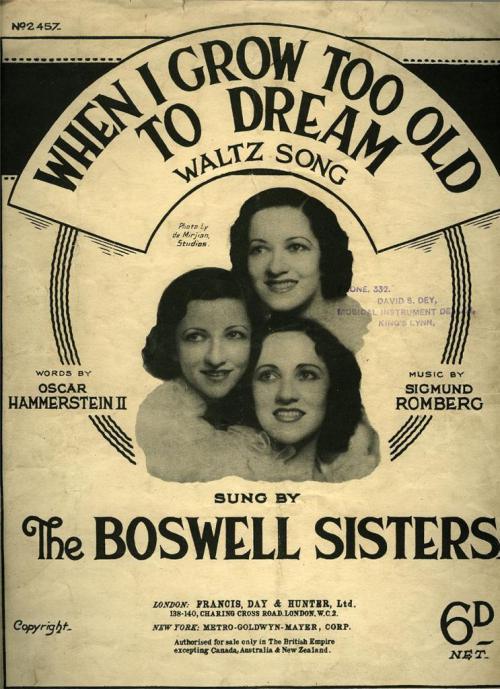
MY FUTURE JUST PASSED
By 1936 it all ended.
The trio broke up.
After over 20 years of making music together––and 5 years at the top––the country’s most popular musical group was no more.
Why did they break up at the height of their success?
The reason given at the time was that Martha and Vet wanted to get married and raise families, while Connie desired a solo career. While this is true, there were deeper dynamics in play.
Perhaps for Connie to have a full-on solo career, she needed to break away from the trio. Harry Leedy––Connie’s husband, and manager for both Connie and the trio––could have contributed in sowing the seeds of dissention by promoting Connie over the group, nudging the trio into the shadows.
Perhaps because the trio had run its course. Intense creativity often embodies the seeds of its own destruction within it.
Why were they largely forgotten?
Maybe because their music was so new and revolutionary, it defied classification.
The music business has a difficult time packaging unique acts. Particularly after they’ve disbanded.
Maybe because their moment in the spotlight was brief––1931 to 1936––and life moved them on in different directions.
Maybe because they were popular during the Great Depression, a time that was so painful that Americans wanted to forget this distressing part of their history.
After the breakup, Martha and Vet did retire from the biz, settled down to married life and raised families. Connie continued on with a successful solo career. In 1942, she changed the spelling of her name to “Connee.” From 1936 to 1954, she had 29 songs on the US charts, including two #1 hits which were duets with Bing Crosby.
But our slot machine hit a once-in-a-google jackpot.
The Bozzies will never be duplicated.
What endures is the amazing musical legacy the Boswell Sisters left to the universe.
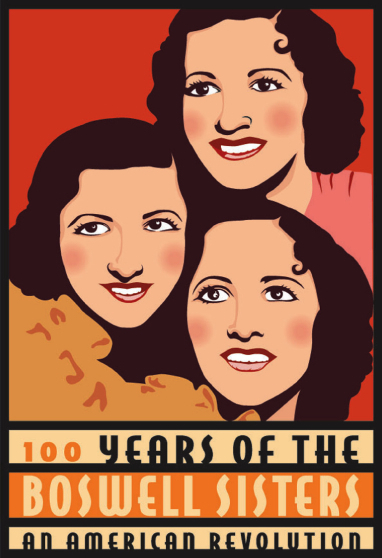
PUT THAT SUN BACK IN THE SKY
After being largely forgotten for over 70 years, there is a resurgence of interest in the Boswell Sisters. The Internet has certainly helped create a new audience. YouTube and Vimeo have provided access to dozens of their songs and some film clips and compilation CDs are readily available.
Tribute groups and Bozzie-influenced bands are growing from all over the globe: the Pfister Sisters, the Puppini Sisters, Boswellmania, the Stolen Sweets, the DeGeleonardo Sisters, the Ditties, the Boswell Project, the Hazelnuts, O Sister! and more. A burgeoning Boswell Sisters Revival is taking place.
The Boswells created their music in the first part of the 20th century, but this isn’t nostalgia. Those 78rpm records may have the audio imprint of another era, but the music itself is still fresh, innovative, and as vibrant as when it was first birthed. The Boswell Sisters deserve wider recognition for their considerable contributions to popular music as well as their important place in American music history.
Thanks to Vet’s granddaughter, Kyla Titus, we now know more of the Boswell Sisters’ story. She wrote a wonderful book, “The Boswell Legacy,” published in 2014. My appreciation of their music deepened the more I learned of their backstory. This book is the best, most authentic source for getting the scoop on the fascinating Boswell saga, from a true insider.
If your appetite for the Boswell Sisters has now been aroused, check out the links below.
Warning…
As I mentioned at the top of this article, listening to Boswell Sisters’ music will put you at risk of “getting Bozzed.”
You can get hooked, finding yourself listening to their songs over and over and over again.
Constant exposure can result in a state of long-lasting euphoria.

ACKNOWLEDGEMENTS:
Source material was compiled from “The Boswell Legacy” by Kyla Titus, Chica Boswell Minnerly, Boswell authority David McCain, Vet Boswell Family Collection LLC, TheBoswellSisters.com, Bozzies.org, “Time For The Boswells” by Dennis Yancey, “Three Perfect Minutes” blog by Bryan Mangum, and “The Boswell Sisters: Close Harmony” documentary by Joshua Tree Productions.
LINKS:
Websites:
The Boswell Legacy book:
Internet Music Archive:
 Paul Chiten is a Los Angeles-based songwriter, composer, producer, musician, singer and artist. His songs have earned him multi-platinum and gold records. His compositions and productions have won Telly, Aurora and Emmy Awards.
Paul Chiten is a Los Angeles-based songwriter, composer, producer, musician, singer and artist. His songs have earned him multi-platinum and gold records. His compositions and productions have won Telly, Aurora and Emmy Awards.
He has worked with Michael Jackson, Anita Baker, Tina Turner, Donna Summer, Cyndi Lauper and countless others.
Paul was Music Director/Orchestrator/Arranger/Performer for the 2015 EMC World event in Las Vegas. He’s currently working on making a large part of his music library accessible for downloading and streaming worldwide. Many of his albums are now available on iTunes, Amazon, Apple Music, Google Play, Deezer, Tidal and Spotify.


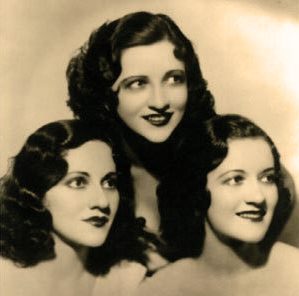
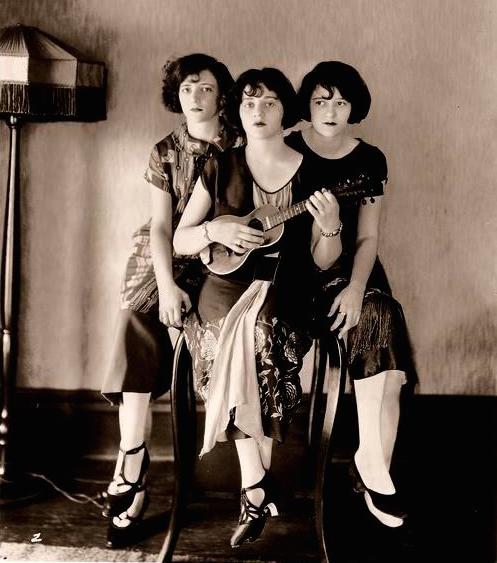
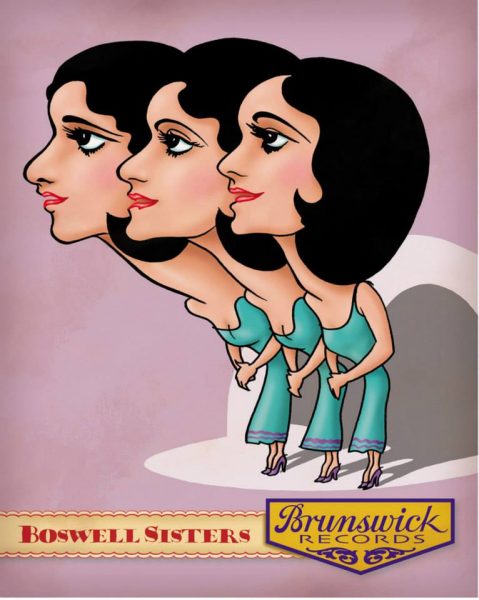


Wonderfully writen! Thank you. Great to learn about these fantastic musicians!
Yay
Off the bat, the title for me was a misnomer, as I had foreknowledge of this astounding close harmony Trio, though I’ll concede, at some point in my life, I did NOT KNOW who the Boswell Sisters were.
But don’t let that throw you if your experience matches mine.
Neither music nor literary critic (l leave that to those better qualified). I will offer that this was an enticing bit of reportage and though somewhat lengthy, a happy marriage of lucid and engaging journalism and sights and sounds, replete with movie clips and sound bites.
Mr. Chiten’s passion for this project is self evident, and his enthusiasm, contagious.
He is to be commended for sharing this with us.
So carve out a block of time with no distractions (if at all possible) and immerse
yourself in the phenomenon that was the Boswell Sisters and get Bozzed!
It is time well spent.
Thank you Paul Chiten for this incredible article! I thoroughly enjoyed this
wonderful story of the Boswell Sisters, and the impressive music you
provided. Your presentation is outstanding! This web page is a rare find.